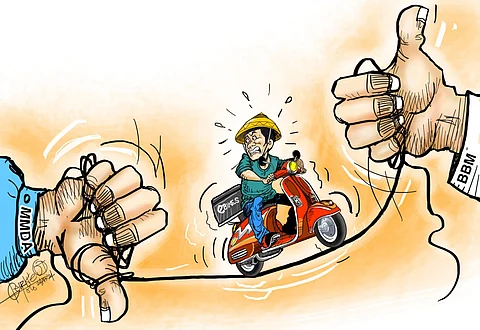
- NEWS
- the EDIT
- COMMENTARY
- BUSINESS
- LIFE
- SHOW
- ACTION
- GLOBAL GOALS
- SNAPS
- DYARYO TIRADA
- MORE

The President’s bold decision to lift the ban on electric bikes and tricycles on national roads for one month is commendable, but it did not augur well for other sectors.
The Metropolitan Manila Development Authority (MMDA) earlier announced it would start implementing on 15 April its Regulation No. 24-022 or the prohibition of e-bikes, e-trikes, tricycles, pedicabs, pushcarts, and kuligligs from traversing national roads, circumferential roads, and radial roads in Metro Manila to promote road safety. Violators would be fined P2,500.
Three days after its supposed implementation, President Ferdinand R. Marcos Jr. ordered the suspension of the issuance of traffic violation tickets, the imposition of fines, and the impoundment of e-vehicles.
Marcos said granting a grace period to e-bikes, e-trikes, and other affected vehicles that pass on certain roads in Metro Manila would allow traffic enforcers from the MMDA and local government units to properly inform the riders of alternate routes and remind them of the new rules to increase safety and order on the streets.
E-bikes and e-tricycles have become increasingly popular modes of transportation in recent years, offering a convenient and eco-friendly alternative to traditional vehicles. However, the rise in their use has also brought about concerns regarding their safety on national roads and the potential risks to riders and other road users.
While the intention behind the ban may be well-meaning, the decision to ban electric bikes and tricycles on national roads could have far-reaching consequences. These eco-friendly modes of transportation have revolutionized mobility for many who cannot afford traditional vehicles. However, implementing such a ban not only restricts their freedom of movement but also threatens the advancement of a greener transportation network.
That being said, the concerns surrounding the safety of electric bikes and tricycles on national roads are not unfounded.
With their increasing popularity, one of the main arguments in favor of banning electric bikes and tricycles is the potential for accidents due to their relatively low speed compared to other vehicles.
While it is true that these vehicles may need help to keep up with the flow of traffic on highways and major roads, it is essential to remember that they are not designed for high-speed travel. In fact, many electric bikes and tricycles have a maximum speed of 20-25 mph, making them more suitable for local roads and bike lanes.
A critical issue is the absence of training and licensing protocols for electric bike and tricycle riders. Unlike drivers of conventional vehicles, there are no standardized training programs or licensing procedures for operating these modes of transportation. This gap has sparked worries about riders’ competence in safely maneuvering on national roads and following traffic regulations.
While these concerns are valid, there may be more effective solutions than banning electric bikes, tricycles, etc. Instead, a more comprehensive approach that addresses both the safety concerns and the need for sustainable transportation options is needed. This could include implementing mandatory training programs for riders, establishing designated bike lanes on national roads, and increasing the enforcement of traffic laws for all road users.
Think about how the ban could hit marginalized communities. For many individuals, these vehicles represent a lifeline to essential services and employment opportunities. Banning them from national roads could further exacerbate existing inequalities in access to transportation and limit the mobility of those who rely on these vehicles for their daily needs.
Think about this: When we ban e-bikes on national roads, we compromise the accessibility, sustainability, and mobility of many individuals. When we allow them, we may compromise safety, traffic flow, and the overall efficiency of the transportation system.
In a nutshell, we have to tread carefully and look at the big picture. Sure, safety is crucial, but we also need to ensure that people have eco-friendly ways to get around. By tackling safety concerns and encouraging responsible riding, we can make the roads safer and more welcoming for everyone through a non-inclusive transport system.
